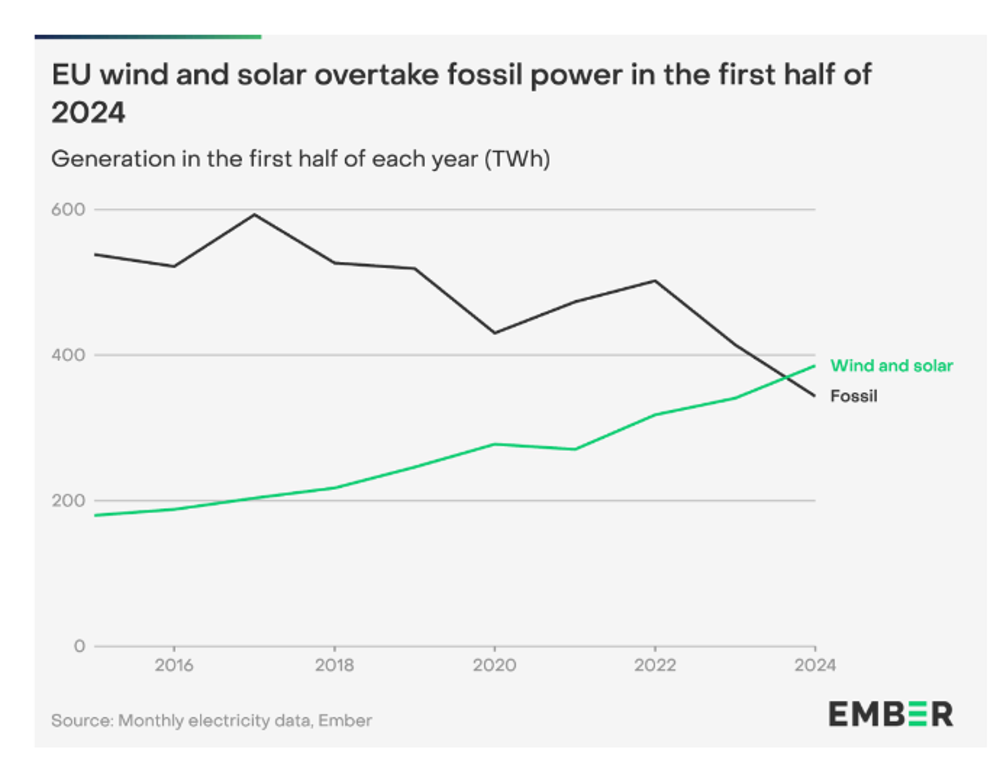Sign up for daily news updates from CleanTechnica on email. Or follow us on Google News!
Ember is a nonprofit based in Europe with a mission to promote a safe climate powered by clean electricity. In a report dated July 30, 2024, it celebrates a milestone for the European Union electrical grid. In the introduction to the report, Ember said, “Fossil generation continues to fall in the EU, even as demand rebounds. Wind and solar rise to new highs, reaching a share of 30% of EU electricity generation and overtaking fossil fuels for the first time.” The achievement has been “a long time coming,” said Euan Graham, electricity and data analyst at Ember and primary author of the report.
While renewable energy has been growing steadily in the EU for years, that trend kicked into overdrive when Russia invaded Ukraine and disrupted the region’s supply of fossil gas. Energy prices climbed so high following the invasion that electricity demand in the region fell in 2022 and 2023. That pullback hurt fossil fuel generation most of all.
Demand is rebounding this year, rising by 0.7% over the first six months, Canary Media reports, and yet fossil fuel generation has continued to fall. Coal generation dropped by 24% and methane by 14% compared to the same period last year. It’s the first time gas and coal generation have declined in the EU without energy demand also trending downward, the report notes.
The EU’s shift toward solar and wind is also due in part to recently passed permitting reforms which have allowed renewables to be built and brought online much faster. “That was the main bottleneck for deploying renewables a few years ago, and it’s in the process of being solved,” said Chris Wright, climate strategy advisor at Ember.
Ember Charts The Rise Of Renewables
In the first half of the year, solar generation expanded by 20% compared to the first half of 2023, while wind generation ticked up by 9.5%, according to Ember. Hydro power also grew by 21%, and combined with solar and wind, the three renewable sources generated half of the EU’s electricity during the period — a jump from the record set last year of 44%.
Emissions from the power sector have declined in turn, falling by nearly one third compared to the first half of 2022 — an even larger decline than during the Covid-19 pandemic. Despite the progress, the report emphasizes that plenty of barriers — such as grid capacity constraints — must be overcome to allow renewables to grow fast enough to deal with the climate crisis.
Ember predicts solar and wind will continue their momentum in the coming months. Nearly 62 gigawatts of solar capacity and 16 gigawatts of wind capacity are expected to be installed in the EU this year, according to forecasts from SolarPower Europe and Wind Europe, setting the two power sources up to continue to exceed fossil fuel generation through at least the first half of 2025. In other words, “It’s very likely that that is a kind of permanent shift in the EU’s electricity mix,” Graham said.
The Ember report says the first half of 2024 shows that the EU’s electricity transition is in full swing, as wind and solar grew fast enough to outpace demand growth and push fossil fuels out of the mix. The EU’s swift action to reduce dependency on fossil fuels was evident as new wind and solar capacity came online, marking a permanent structural change. However, sustaining the EU’s electricity transition at this pace will require dedicated policy focus to ease barriers to wind and solar integration. Adequate support on grid connections and other enablers of swift development will be needed to ensure that economic, security and climate benefits are delivered across Europe.
Fossil Generation Plummets

The first half of the year shows fossil generation’s narrowing role in the power sector and gains for renewables that are beyond temporary variations in conditions, the report continues. “We are witnessing a historic shift and it is happening rapidly. If Member States can keep up momentum on wind and solar deployment then freedom from fossil power reliance will truly start to come into view,” says Chris Rosslowe, a senior energy and climate data analyst at Ember.
Coal generation dropped steeply, the Ember report shows, with a 24% fall compared to the same period last year (-39 TWh). This was more than half of the 71 TWh fall in fossil generation. Methane gas generation fell by 14% (-29 TWh). This follows sizeable falls in the previous year: in the first six months of 2023, coal fell by 21% (-45 TWh) and methane gas by 16% (-39 TWh). Over 75% of the fall in fossil generation came from just five Member States, driven by the EU’s largest power sectors. The largest decline was in Germany, where fossil generation fell by 19 TWh (-16%). Coal supplied 20% of Germany’s electricity in the first half of 2024, down from 26% in the same period in 2023.
Weather played a role in reducing the demand for electricity in the EU this winter. Demand likely would have risen further if not for a warmer than average winter in many EU countries, which lowered electricity demand for heating. Without the impact of mild winter weather, demand would have increased by an estimated 2.1%, aligning with the IEA’s forecast that EU electricity demand will increase by an average of 2.3% per year between 2024 and 2026.
Across the EU, solar generation increased by 21% (+25 TWh) compared to the first six months of 2023, while wind generation rose by 9% (+20 TWh). Almost half of the growth in wind generation came from just two countries –Germany (+5.5TWh, +8.4%) and the Netherlands (+4.6 TWh, +35%). The growth in solar is more widespread, with strong capacity additions leading to large generation increases across the EU, including in Germany (+4.5 TWh, +14%), Spain (+2.7 TWh, +13%), Italy (+2.6 TWh, +17%) and Poland (+2.4 TWh, +37%). Relative growth was even faster in other countries with Hungary’s solar generation increasing 49% (+1.5 TWh) in the first half of 2024 as compared to the same period in 2023.
The Ember report points out that nuclear power generation increased during the first half of 2024 in France, where some nuclear facilities that had been taken offline for maintenance and repairs were reactivated. That was offset somewhat by Germany’s decision to shutter the last of its nuclear generating facilities at the end of 2023. Overall, the share of electricity from nuclear sources increased compared to the same period in 2023.
Hydro power also increased in the first half of 2024. After years impacted by severe drought, Europe experienced higher than average rainfall in the first half of 2024. As a result, hydro generation rebounded by 21% (+33 TWh) to reach the highest output since 2018. Some Member States saw particularly large upticks in hydro output. Italy increased by 56% (+8.5 TWh), France by 35% (+9.3 TWh), Spain by 54% (+6.9 TWh) and Portugal by 69% (+3.5 TWh). Overall, hydro generation was 15% higher in the EU than the average generation in January-June over the
last 5 years.
EU Emissions From Electricity Generation Tumble
As fossil fuels fell and wind and solar continued to grow, power sector emissions dropped by 17% in the first half of 2024 compared to the same period last year. This follows a similarly large fall of 18% between January and June of 2023. As a result, emissions in the first half of the year are now nearly a third (-31%) lower than in the first half of 2022, an unprecedented decline over such a short period. This decline is even larger than the fall seen over the same periods in 2020 and 2018, which reflected the impact on demand from the Covid-19 pandemic.
Compared to the first half of 2017, emissions from the EU power sector are now down 44%. That is an enormous reduction that speaks to the power of renewables to address the continuing challenges posed by an overheating planet.
The Takeaway
More electricity from renewables and less from fossil fuels is always welcome news. But as the Ember report points out, the transformation of the EU’s electricity system has been swift over recent years. The first half of 2024 in particular has seen almost unprecedented falls in fossil generation despite demand growing. Renewable energy has played a vital role in alleviating high power prices in the EU, but sustaining the pace of this transition will not be an easy feat. It will require dedicated policy action and implementation to ease barriers to future wind and solar deployment.
In other words, the job is not over and probably never will be until all electricity on Earth is made from renewable energy resources. That’s a scenario that sends a chill wind through the C Suites of fossil fuel companies, but it is absolutely essential if humans are to continue inhabiting the Earth for decades, centuries, and millennia to come.
Have a tip for CleanTechnica? Want to advertise? Want to suggest a guest for our CleanTech Talk podcast? Contact us here.
Latest CleanTechnica.TV Videos
CleanTechnica uses affiliate links. See our policy here.
CleanTechnica’s Comment Policy





